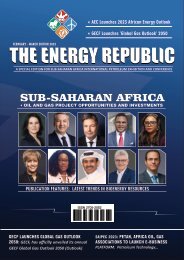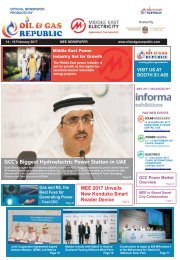OGR July - August Edition 2020
This publication provides latest stories in Africa, COVID-19 Pandemic in Africa, and key recommendation from industry experts on how Africa can navigate through the global pandemic.
This publication provides latest stories in Africa, COVID-19 Pandemic in Africa, and key recommendation from industry experts on how Africa can navigate through the global pandemic.
You also want an ePaper? Increase the reach of your titles
YUMPU automatically turns print PDFs into web optimized ePapers that Google loves.
COUNTRY REPORT
Cameroon Launches Exploration
Opportunities in two Producing Basins
Within its mandate to promote and
valorise hydrocarbon resources in
the mining property of the Republic
of Cameroon, the National Hydrocarbons
Corporation (SNH) has launched the
promotion of nine blocks in the
hydrocarbons rich Rio del Rey Basin (RDR)
and in the highly prospective Douala/Kribi-
Campo (DKC) Basin. These blocks are
Ndian River, Bolongo Exploration and
Bakassi (in RDR), Etinde Exploration, Ntem,
Elombo, Tilapia, Bomono and Kombe-
N'sepe (in DKC).
Douala/Kribi-Campo Basin
The Douala/Kribi-Campo Basin, covering a
total area of 19000 km², is the
northernmost basin of the South Atlantic
rift. It lies between the prolific petroleum
producing Niger Delta to the North and the
Rio Muni Basin to the South.
Source rocks have been identified from
several stratigraphic levels including the:
• Aptian/Albian
• Upper Cretaceous
• Oligocene/Miocene
(Souellaba)
• Potential Paleocene/Eocene (N’kapa)
All the oil properties indicate that oils
originate from terrigenous dominated
source rocks deposited in a marine
environment. Abundant oil seeps exist at
the basin margins. Hydrocarbon bearing
reservoirs have been encountered at nearly
every stratigraphic level from the Miocene
(Souellaba) down to the Albian/Aptian
(Upper and Lower Mundeck) and across a
variety of depositional systems from
continental to deepwater fans.
Rio del Rey Basin
The Rio Del Rey (RDR) Basin is a divergent
margin basin formed as a result of the Aptian
to Albian opening of the South Atlantic
Ocean.
The basin sedimentary fill corresponds to
the easternmost edge of the prolific Tertiary
Niger Delta complex. It is separated
geographically from the Douala/Kribi-
Campo Basin by the Tertiary Cameroon
Volcanic Line.
The basin has four structural provinces,
defined on the basis of deformation types:
• The Growth Fault Province in the North:
differential loading of deltaic and
continental sediments on underlying
prodelta marine shale generated E - W
trending synsedimentary faults.
• The Shale Ridge Province in the
Southwest: the overburden of deltaic and
continental sediments triggered squeeze
flow of underlying mobile shales of the
Akata Formation forming diapirs (shale
domes, mud volcanoes, shale ridges).
• The Delta Toe-Thrust Belt in the South
central area: zone of compressional/
transpressional thrust structures.
• The Eastern Province in the Southeast:
slightly deformed foreland area juxtaposing
the Cameroon Volcanic Line.
The general stratigraphy (see stratigraphic
summary chart) is equivalent to that of the
Niger Delta and is made up of three main
diachronous formations in the basin, as
described in the table below. Only one well
penetrates the Cretaceous section,
made up of sand and shales with source rock
potential.
SNH is a public industrial and commercial
company with financial autonomy, created
in 1980. It has the mission to promote and
valorize the national mining domain and
manage State interests in the hydrocarbons
sector.
To accomplish these missions, SNH is
notably empowered to:
• conduct studies related to hydrocarbons;
• collect and store related information;
• conduct negotiations of oil and gas
contracts, and much more...
48
OIL AND GAS REPUBLIC I SPECIAL EDITION















